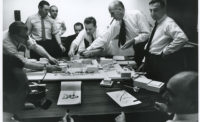Near the end of writer/director Stephen Gee’s film Iconic Vision: John Parkinson, Architect of Los Angeles—which premiered on PBS SoCal in July and is now airing across the country—narrator John Grunewald says, rather matter of factly, “His name might not be familiar to many Los Angeles citizens, yet John Parkinson and Los Angeles are forever entwined.” That lack of local familiarity is undeniable at the national level. In an architectural conversation with a solid eastward tilt, we rarely talk about Southern California’s built environment or the people responsible for it (except when Frank Gehry comes to town). So if Iconic Vision is an eye-opening introduction for Angelenos, it’s revelatory for the rest of us.
Over a 45-year period, Parkinson helped turn L.A.—barely a city when he arrived in 1894—into a metropolis with a place on the global urban stage. He designed the Laughlin Building, the city’s first steel-frame structure (1896); the city’s first skyscraper, the 12-story Braly Block, now called the Continental Building (1904); and the Wholesale Terminal Market (1917). The University of Southern California campus, as it exists today, is Parkinson’s work, including the Los Angeles Memorial Coliseum (1932). He designed the city’s iconic City Hall (1928), the Art Deco masterpiece Bullocks Wilshire department store (1929), and the indelible, Spanish mission-style Union Station (1939).
That legacy is a world away from his origins. Born in England on December 12, 1861, Parkinson grew up in a working-class family in an era when architects came from the building trades. As a young adult, he bounced between Manitoba, Minnesota, the U.K., and California, working as a builder’s apprentice, building fences and stairs, then serving as a mill foreman. He eventually landed a commission to build expand the Bank of Napa, which elevated him to practicing architecture.
Parkinson moved to Seattle in January 1889, where he made his mark as an architect. The Butler Block project (1891) earned praise and led to a 16-room schoolhouse, which in turn led to his designing 32 schools in the Pacific Northwest and becoming Seattle’s first Schools Architect and Superintendent of Construction.
The economic depression of 1893 left Parkinson unemployed and nearly broke, making Southern California’s promise of boom and growth all the more enticing. What he eventually accomplished there is breathtaking by any measure. Spend any time in L.A. and you’re likely to encounter multiple Parkinson buildings—and not only the showstoppers, but everyday structures like hotels, offices, and apartment buildings. “John Parkinson should be considered one of the founders of Los Angeles,” historian Kevin Starr says in the film.
After watching Iconic Vision, it’s hard to argue the point. The 57–minute film makes a compelling case for Parkinson’s place in architecture. But Gee goes beyond the work to give us a sense of the man. We learn about his 10-year partnership with Edwin Bergstrom, who would later be the lead Pentagon designer; the role Parkinson’s son, Donald, played in the firm; the architects sudden death of a heart attack in 1935 at the age of 73; Donald’s death, also of a heart attack, 12 years later; and Donald’s son suicide in 1955.
The problem is we don’t do much more than learn. The documentary zips along like a sedan booking it down the freeway: we take in the sites of Parkinson’s life and career but rarely have the chance to consider what we’re given. Even if we’re too often left begging to pull over and linger just a little longer on a particular building or personal moment, Iconic Vision offers a valuable primer on one of the great, overlooked architects of the 20th century.









